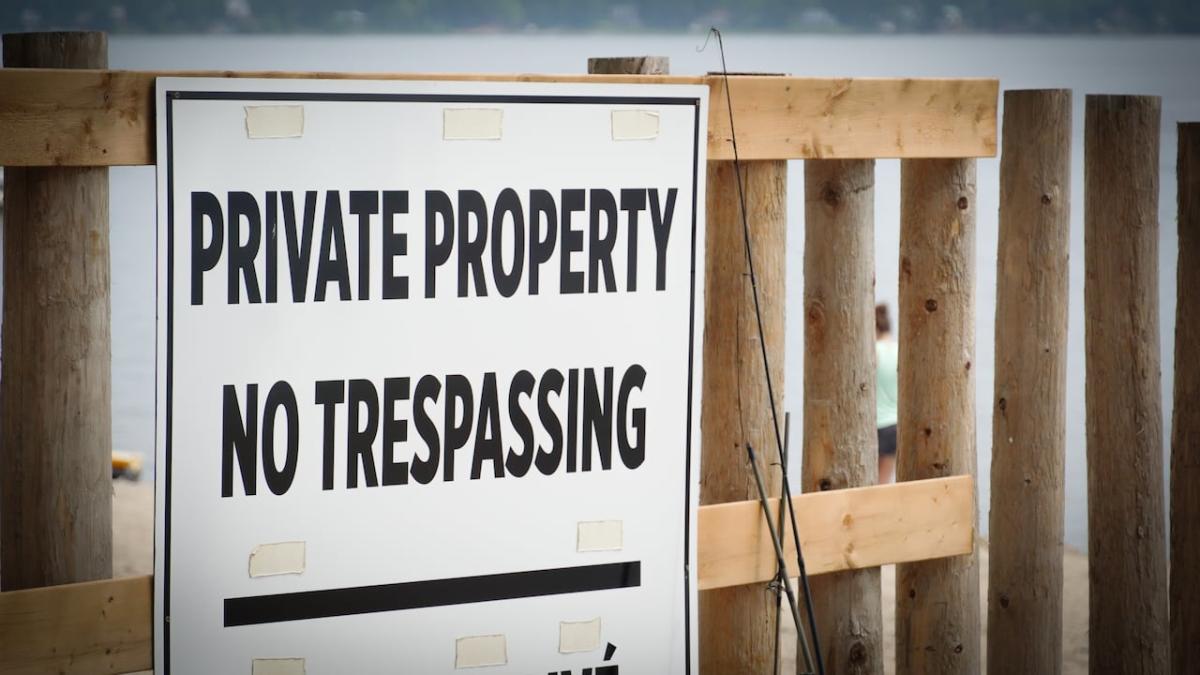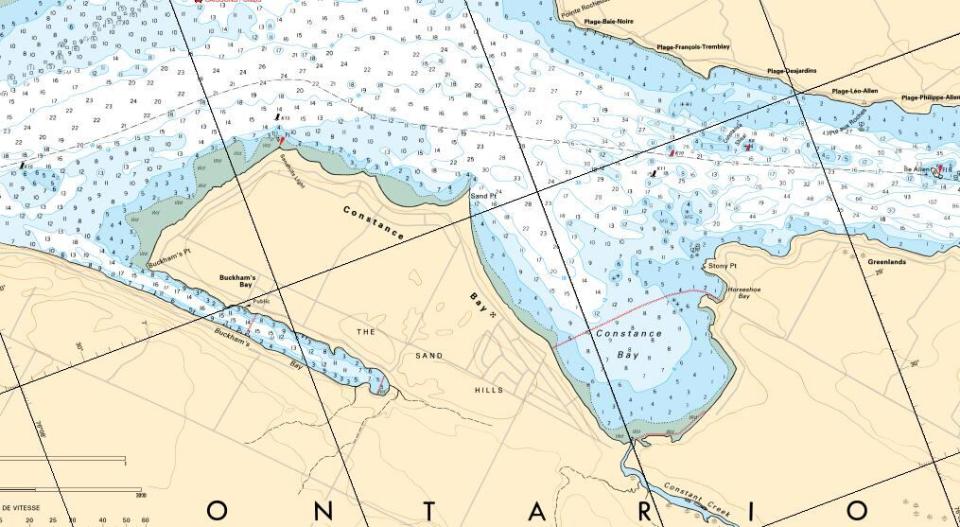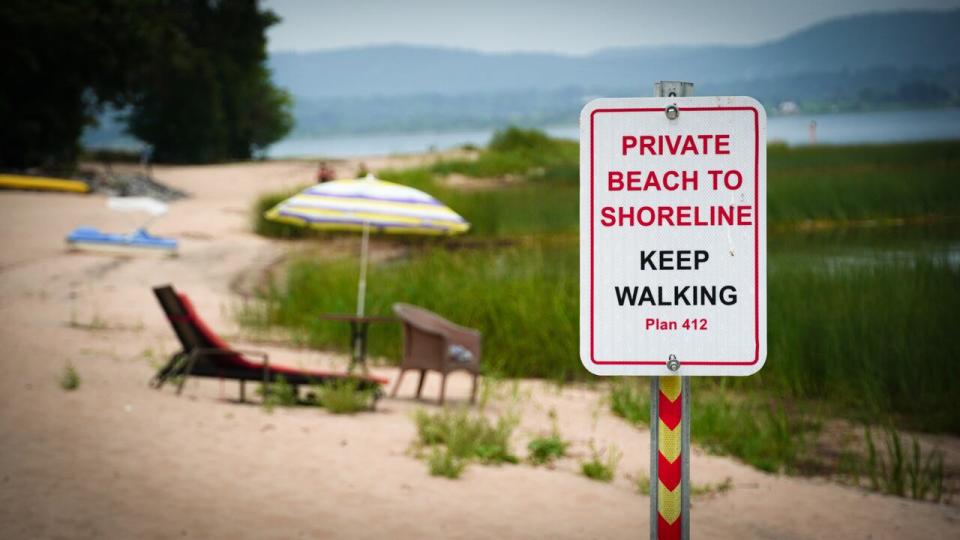


A fence that runs across the sand and into the water at a Constance Bay beach colloquially known as The Point has some questioning whether waterfront property owners have the legal right to build structures on the shorelines that front their properties.
In Ontario, some do, according to a lawyer consulted by CBC News. While she couldn’t comment on the Constance Bay case, Margot Pomerleau, a partner with the Ottawa-based firm MBC Law, explained it depends on two factors: shoreline ownership and “riparian rights.”
“A riparian boundary is that line that you have between you and the water,” Pomerleau said. “So when we’re talking about riparian rights, we’re talking about what kind of rights does everybody have with respect to the boundary that they share?”

Margot Pomerleau, a partner at MBC Law, says a homeowner’s rights to use and access the shoreline and water bordering their land is determined by an area of property law known as riparian rights. (Submitted by Margot Pomerleau)
Pomerleau said many landowners aren’t aware that the Crown owns the beds of most bodies of water in Ontario, and has since it first subdivided parcels of land for private ownership.
Some still believe waterfront property owners own up to the “high-water mark,” but Pomerleau said that’s now an outdated term no longer used to legally describe the riparian boundary between private and Crown property in Ontario.
“If you own to what used to be the high-water mark … that is now the water’s edge,” said Pomerleau.
Ontario owns most beds in the province due to the Beds of Navigable Waters Act, which stipulates its jurisdiction over waterways that have value to the public as a means of travel or transport from one point of public access to another.
Transport Canada considers the Ottawa River navigable from Lake Timiskaming to the St. Lawrence River.
Based on charting by the Canadian Hydrographic Service – part of Fisheries and Oceans Canada – Constance Bay sits upon a stretch of the river that is navigable, including at Sand Point.
A spokesperson from Ontario’s Ministry of Natural Resources added the lands below the water’s edge of the Ottawa River are public.


Constance Bay sits upon a stretch of the Ottawa River that is navigable, including at Sand Point where its popular beach is located. (Submitted by Fisheries and Oceans Canada)
Determining riparian rights
A property’s legal boundary determines the riparian rights that may apply to it.
Pomerleau recommends property owners refer to documents registered at the time of purchase such as reference plans, deeds and property descriptions. She also suggests they consult surveyors and lawyers to determine exactly where their property lines extend and what their riparian rights may be.
The fence dividing residents and beachgoers in Constance Bay went up in May at a rental property at 122 Lane St. CBC News has reached out to the property owners who have not responded to repeated requests for comment.


The fence at 122 Lane St. first went up in May. (Maxim Saavedra-Ducharme/CBC)
However, CBC obtained a copy of a reference plan for the property filed last November through Ontario’s land registry services.
The document indicates the lot, which sits on registered plan 412, extends to the shoreline — one piece of evidence that may suggest the property extends to the water’s edge of the Ottawa River, said Pomerleau.
CBC also obtained a copy of subdivision plan 412, which notes all lots fronting the river extend to the shoreline.
Clarke Kelly, the city councillor for West Carleton–March, said he has received “many” questions about the fence at the Lane Street property. He wrote to his constituents that owners can delineate the boundaries of their property so long as they refer to their property’s legal survey and follow the City of Ottawa’s fence bylaw.


The Lane Street property is part of subdivision plan 412, registered through Ontario’s land registry services. The document notes all the lots on the plan fronting the Ottawa River extend to the shoreline. (Maxim Saavedra-Ducharme/CBC)
For fences that extend to the shoreline, Clarke said, property owners should first consult the Mississippi Valley Conservation Authority or the Ministry of Natural Resources.
In response to Kelly’s inquiry about the Lane Street fence, the Mississippi Valley Conservation Authority confirmed the fence does not require a permit because it doesn’t affect the movement of water.
Limits on riparian rights
The right of property owners to access water can sometimes include the right to build structures that run into it, Pomerleau said.
“That could be set up in a subdivision plan, or a Crown patent for example,” she said. “There could be a right of certain lot owners to [traverse] other lanes or private property to gain access to the water.”
Based on the registered subdivision plan associated with 122 Lane St., there’s no evidence that right applies to the property.
However, in cases where a property owner’s riparian rights do allow them unique access to water or other private property, they must still abide by provincial legislation and municipal regulations.
City investigating Lane Street fence
The City of Ottawa found that the Lane Street fence did not comply with the city’s fence bylaw when it was first erected in the spring, said Jennifer Therkelsen, acting director of bylaw and regulatory services.
While the city doesn’t own the shoreline, it does own 39 road access points to the beach throughout Constant Bay.
Initially, part of the fence was built on the city’s right of way, said Therkelsen. The property owners promptly removed the section and it was then deemed compliant.
But Therkelsen said “following more recent modifications,” a new investigation has been opened to assess whether the current fence still meets the city’s standards. The city did not define what changes were made as the investigation is underway.
A spokesperson from the Ministry of Natural Resources said it cannot comment on whether the fence is authorized, but that it is “aware of this occupation and is currently considering the matter.”